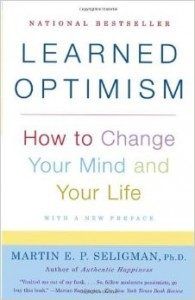Learned Optimism: Is Martin Seligman’s Glass Half Full?
 Can you learn to have a positive outlook? And if you could, how would that change your life?
Can you learn to have a positive outlook? And if you could, how would that change your life?
Learned optimism is a concept from positive psychology’s founding father, Martin Seligman, that argues that we can cultivate a positive perspective.
With a more joyful outlook on life, he explains, we’re in a much better position to enhance our wellbeing.
This article is about the learned optimism concept and its benefits, as well as how you can start to change your mindset and life. If you’d love to lead a life from a ‘glass half full with a splash of ice’ perspective, then read on to learn more.
But first, we thought you might like to download our three Positive Psychology Exercises for free. These science-based exercises explore fundamental aspects of positive psychology, including strengths, values, and self-compassion, and will give you the tools to enhance the wellbeing of your clients, students, or employees.
This Article Contains:
What Is Learned Optimism in Psychology?
Put succinctly, learned optimism is a concept that says we can change our attitude and behaviors by recognizing and challenging our negative self-talk, among other things. It’s also the title of Seligman’s well-known book, which delves into the theory a little further.
A little background
The aim of positive psychology is to begin to catalyze a change in the focus of psychology from preoccupation only with repairing the worst things in life to also building positive qualities.
Seligman & Csikszentmihalyi, 2000, p. 5
Learned optimism is very much a positive psychology concept; it’s the opposite of learned helplessness: a phenomenon whereby individuals believe they are incapable of changing their circumstances after repeatedly experiencing a stressful event (Abramson, Seligman, & Teasdale, 1978; Seligman & Garber, 1980; Maier & Seligman, 2016).
Coming originally from a clinical psychology background, and with a lot of his work centered on pessimism, Seligman became curious why some individuals don’t feel helpless even when conditioned to do so. His interest shifted, and he started to look into how we could condition individuals to be more optimistic instead (Peterson, 2000).
Some of his earlier work began to consider how optimism and pessimism were related to how people explained the cause of challenges and adverse events, which set the stage for more studies into other subjects:
- The individual benefits of optimism, compared to pessimism
- Its impact on health, wellbeing, and success
- How people can learn to become more optimistic – learned optimism
Benefits Found in Research

Pessimism has been defined as: “[the] anticipation of good or bad things to happen in the future” (Carver, Scheier, & Segerstrom, 2010). Optimism is often considered the opposite but can be thought of in different ways.
Carver et al. (2010, p. 879) defined optimism from a dispositional standpoint, as “an individual difference variable that reflects the extent to which people hold generalized favorable expectancies for their future.”
According to Seligman’s (2007, p. 52) explanatory style definition, “The basis of optimism does not lie in positive phrases or images of victory, but in the way you think about causes.”
From here, we can see where the idea of ‘learnability’ originated.
A few benefits of optimism include the following.
1. Improved health
Several studies illustrate the different ways that optimism positively impacts our health.
In a study of head and neck cancer patients, optimistic patients reported a higher quality of life both before and after treatment, suggesting that their positive outlook buffered the effects of health-related distress (Allison, Guichard, & Gilain, 2000). Similar findings of lower distress have been reported in individuals undergoing treatment for breast cancer (Carver et al., 1999).
Optimistic individuals also tend to be more aware of their health status and how to stay that way. Specifically, Radcliffe and Klein’s (2002) research studied 146 middle-age adults and found that those with high optimism were more informed about heart attack risk factors, as well as the role of other risk factors on their health: stress, alcohol consumption, nutrition, smoking, fat consumption, and exercise.
Optimists may also take a more approach-focused method of dealing with health stressors. Rather than trying to avoid, ignore, or withdraw from a health concern, optimistic people are more inclined to seek practical support, cognitively restructure, or reinterpret the situation positively, among other coping methods (Solberg Nes & Segerstrom, 2006).
Optimistic people are also less likely to need rehospitalization after a coronary bypass or repeat cardiac operations (Scheier et al., 1999; Helgeson, 2003; Cauley et al., 2017). Compared to pessimists, optimists are also less likely to develop high blood pressure (Everson, Kaplan, Goldberg, & Salonen, 2000), suffer from stress-induced changes in immunity (Kubzansky, Sparrow, Vokonas, & Kawachi, 2001), and even develop heart disease in the first place (Brydon, Walker, Wawrzyniak, Chart, & Steptoe, 2009).
2. Motivation and performance
At work, optimism has been linked to intrinsic motivation to work harder, endure during stressful circumstances, and show more goal-focused behavior (Luthans, 2003).
As an important contributor to employees’ wellbeing, it has been linked to improved overall happiness in the workplace, task orientation, solution-focused approaches, perseverance, and decision-making efficacy (Strutton & Lumpkin, 1992; Norman, Collins, Conner, Martin, & Rance, 1995; Podsakoff & MacKenzie, 1997; Chiok Foong Loke, 2001; Harter, Schmidt, & Keyes, 2003; Gavin & Mason, 2004).
This higher motivation was also shown in studies of college students (Solberg Nes, Evans, & Segerstrom, 2009). In academic contexts, higher optimism was also coupled with better grade point averages, perhaps because optimistic tendencies have been linked with higher persistence (Segerstrom & Solberg Nes, 2006).
3. Career success
Seligman himself researched the optimism levels of Metropolitan Life Insurance (MetLife) agents in 1985, a study that he describes in Learned Optimism. At the time, MetLife was struggling with poor staff retention rates despite investing vast amounts in training, so Seligman introduced an optimism test to their screening process.
Because the company was short on employees, they hired a few who scored below the cut-off point. Two years after hiring, the optimistic employees had sold 31% more than the pessimists (Seligman & Schulman, 1986; Seligman, 2006).
Furthermore, those candidates who had failed the company’s aptitude test and scored well on the optimism test did 57% better than the pessimists in the second year, suggesting that optimism played a more significant role than selling proficiency.
Elsewhere, career optimism has also been linked positively with subjective career success, job satisfaction, and the external marketability of female academics (Spurk, Kauffeld, Barthauer, & Heinemann, 2015). It has even been linked with higher career adaptability (Tolentino et al., 2014), which is “a set of attitudes, competencies, and behaviors that individuals use in fitting themselves to work that suits them” (Savickas, 2013, p. 45).
With so many promising findings, it’s encouraging that optimism can be learned. But if that’s the case, how do we get started?
Can Optimism Be Taught?
“Life inflicts the same setbacks and tragedies on the optimist as on the pessimist, but the optimist weathers them better.”
Seligman, 2006, p. 312
The positive psychology view of learned optimism is about how we interpret the world, and according to this premise, it’s not a fixed trait nor part of our disposition. Instead, it can be seen as more of a strategy – an outlook that we can learn to cultivate when we start by challenging our automatic negative thoughts.
Some studies suggest that optimism interventions can improve people’s optimism significantly, with the face-to-face Best Possible Self intervention having the most significant effect of all studied (Meevissen, Peters, & Alberts, 2011; Layous, Nelson, & Lyubomirsky, 2013; Malouff & Schutte, 2015).
In short: if it can be learned, it can be taught, Seligman (2006) would argue.
What Causes Pessimism?

Hecht (2013) discusses a couple of cognitive and perceptual reasons why people tend to be either optimistic or pessimistic.
Attention and information processing
First, it may be down to how we process information and our selective attention. Think of it this way: the glass is either half full or half empty depending on where your focus lies, right?
Assuming you’re thirsty, the presence of water in the glass is a positive environmental cue; paying more attention to its presence than its absence is optimistic. You disregard the fact that half the glass is not filled, filtering out the cues that don’t correspond with your positive outlook. And eye-tracking studies suggest that pessimists do the opposite, spending more time looking at unpleasant cues than optimistic people (Isaacowitz, 2005, 2006).
Locus of control
Hecht (2013) describes a second potential cognitive mechanism – the locus of control – which refers to our confidence that we can change or control elements of our lives. An internal locus of control is associated with optimism; this is the belief that you can take an active role in controlling things like exam results, work performance, and your environment in general.
In contrast, those with an external locus of control tend to feel helpless about changing their relationships, lives, and so forth. The latter, Hecht argues, is pessimistic.
While your locus of control and optimism can be viewed as conceptually distinct – think about perceived self-efficacy and luck, for instance – there is doubtless some overlap between the two (Peacock & Wong, 1996).
Attributional style
When we explain or attribute failure to internal, fixed, personal factors, we see them as uncontrollable. A failed relationship, for example, becomes “I’m not lovable” – a pessimistic outlook.
When we attribute failure to external, localized, and transient circumstances, we can feel hopeful for better results next time. “I didn’t beat my personal best because I have the flu, but I’ll swim faster when I’m well.” This is distinctly optimistic.
Attributional styles also apply to positive outcomes, but the other way around. Viewing good results as due to global, stable factors inside ourselves is optimistic. “I aced that because I’m a great student.” Attributing them to temporary and uncontrollable causes is pessimistic. “Wow, that was a one-off. It’s downhill from here” (Abramson et al., 1978).
The Attributional Style Questionnaire is a self-report measure often used to measure explanatory styles and optimism.
Returning to our original question, there are a few potential psychological reasons why we may be pessimistic at specific times, or in general. Learned optimism is the idea that these can be addressed.
How to Improve Optimism
There are a few ways to improve your optimism. Seligman recommends Albert Ellis’s ABC technique in Learned Optimism, and it doesn’t hurt to know more about the cognitive distortions that need to be changed.
Cognitive distortions – The 3 Ps
Three cognitive distortions tend to underpin the way we understand our experiences: personalization, pervasiveness, and permanence. By tackling these distortions, we can learn to be more optimistic.
Personalization can be thought of as an internal vs. external attribution style. If something bad happens, a pessimist will attribute it to internal factors. They’ll see that failure or setback as something that’s their fault, personalizing the outcome. Optimists externalize instead; they aren’t to blame, and next time may be better.
Pervasiveness describes the global or specific element of adversity or a negative event. A global or pervasive attribution is pessimistic and closely related to catastrophizing. “I did a terrible job; I’ll never be hired again – EVER.” Someone who views an undesirable outcome as pervasive will also be more inclined to believe that it will impact other aspects of their lives, too. “It means I’m a bad student, too, and unlovable (again).” Optimists see positive events as pervasive, it can be argued, rather than negative ones.
Permanence is about whether we view a negative situation as fleeting or lasting and unchangeable. A pessimistic explanatory style sounds something like: “I’ll always be a terrible dancer. It’s just who I am.” A positive one sounds more like: “I probably didn’t dance so well because my leg is currently hurting, but I’ll be back on top soon.” The key takeaway here is that the situation or circumstances are not fixed or unchangeable.
How to become more optimistic – The ABC technique
We can change our explanatory styles by challenging these cognitive distortions. In Learned Optimism, Seligman introduces an adapted version of Dr. Albert Ellis’s ABC technique. We’ll use an example to illustrate how it works.
The acronym ABC refers to:
Antecedents/Adversity – e.g., You’re fighting with a friend.
Beliefs/Behavior – e.g., “Wow, I’m an awful friend and always will be.”
Consequences – e.g., You don’t try to make peace with your friend because you can’t change who you are.
Your explanatory style is how you get from A to B, and this is what Seligman argues that we can learn to change. It’s where one, two, or all of the three Ps come into play. Which one(s) did you notice here?
Relearning your own ABC process is about becoming more aware of these cognitive distortions or pessimistic explanatory styles, confronting them, and replacing them with more optimistic and adaptive thoughts. Simply understanding these relationships is often the first step to changing the way you think to a more hopeful one (Saelid & Nordahl, 2017).
Read more about Albert Ellis’s ABC Model or access our Cognitive Distortions worksheets.
Learned Optimism: Martin Seligman’s Book Summary

The pleasant life is about amplifying positive emotion and acquiring the skills to do this.
The engaged life is one where you discover your highest strengths and reshape your life to make the most of them in relationships, leisure, and work.
The meaningful life involves utilizing those strengths to “belong to and serve something you believe is larger than the self” (Seligman, 2006, p. iv).
The book is broken down into three sections: The Quest, The Realms of Life, and Changing.
Seligman (2006) refers to a vast and extensive body of optimism literature to illustrate its beneficial impacts on quality of life, performance, motivation, health, and other life domains. It’s a combination of practical techniques about breaking pessimistic habits and replacing them, and a discussion of the skills that optimism involves.
It features a good deal of detail regarding the experiments he was academically involved in and anecdotes about how relevant theories were developed. Learned Optimism also covers the potential dangers of extreme or unrealistic optimism and gives some easy-to-digest pointers on how to be adaptively optimistic, such as:
- Being grateful for your blessings
- Helping others in greater need than yourself
- Challenging the utility of your negative thoughts and beliefs
- Tackling negative self-talk head-on
As well as the theory and practical exercises, Seligman’s book includes the Learned Optimism Test, which helps the reader understand their existing explanatory styles in greater depth. He also includes some material about how to cultivate optimism in children that caregivers, educators, and parents will likely find valuable.
You can find the book Learned Optimism: How to Change Your Mind and Your Life on Amazon.
The Learned Optimism Test
Chapter 3 of Learned Optimism features a 48-item test that can assess the three dimensions of your explanatory style: personalization, pervasiveness, and permanence.
For each, you’re asked to imagine each situation happening to you and select the response that best describes what you would think. Here are some examples. Note that some items are reverse-scored (Seligman, 2006).
- You run for a community office position, and you win. (Pervasiveness)
- I devote a lot of time and energy to campaigning.
- I work very hard at everything I do.
- You forget your partner’s birthday. (Personalization)
- I’m not good at remembering birthdays.
- I was preoccupied with other things.
- You owe the library $10 for an overdue book. (Permanence)
- When I am really involved in what I am reading, I often forget when it’s due.
- I was so involved in writing the report that I forgot to return the book.
5 Learned Optimism Exercises

1. Exploring Explanatory Styles
This Exploring Explanatory Styles exercise from our Positive Psychology Toolkit© is designed to help you or your client experience the difference between interpreting and explaining events in everyday life.
Part One of this activity involves visualizing a hypothetical adverse scenario from a pessimistic point of view, then from an optimistic one. You are asked to imagine you’ve faced a setback, and then the exercise guides you through different elements of the situation that you can consider.
It uses the ideas of permanence, pervasiveness, and personalization to help you see it from both explanatory styles. Then it provides some evaluation questions to trigger self-reflection, for example:
Was there a difference in how you felt in each of these mindsets?
Did one mode feel more familiar to you than the other? If so, which?
In Part Two, you repeat the same steps with a positive hypothetical. The table below gives a concise overview of the concepts at play:
| Optimistic explanatory style | Pessimistic explanatory style | |
|---|---|---|
| Positive life event | Permanent Pervasive Personal/Internal |
Temporary Local General/External |
| Negative life event | Temporary Local General/External |
Permanent Pervasive Personal |
2. Thought Record Worksheet
Tackling cognitive distortions, as we mentioned, is part of learning to be more optimistic. This involves being aware of your thoughts, trying to be objective about them, and challenging them (Miller, 2001).
You can use this worksheet to record negative thoughts and look at whether some of them are related to any of the 3 Ps. Then you come up with evidence to support the thought and evidence that contradicts it.
For example, if you missed your son’s basketball game, your thought might be, “I am a terrible mother who will never be there for her son.”
You might then consider the evidence at hand – e.g., you got stuck in traffic – and come up with a more adaptive thought, such as, “That road construction was to blame, and next time I’ll leave earlier to be on time.”
Here is our free Thought Record Worksheet.
3. ABC Functional Analysis
As we’ve discussed, the ABC technique can help you understand what underpins your behavior and its consequences.
There are three columns for Antecedents, Behavior, and Consequences on this sheet, and you can use it to explore your explanatory style in both positive and negative situations.
Using the information in our How to Improve Optimism section, you may find this worksheet helpful in challenging a pessimistic explanatory style when you become aware of it.
4. Tapping Into Your Inner Optimist
The extent to which you can successfully influence your explanatory style has an impact on how you experience the event both affectively and behaviorally. The Tapping Into Your Inner Optimist exercise aims to help you explore the difference between attending to negative or positive information.
It helps you become aware of your ability to view situations from a particular perspective.
The first step is called Tapping Into Your Inner Pessimist, and you’ll ask yourself questions such as:
What were some things that annoyed you this week?
What difficulties did you face at work?
The second step involves taking a more optimistic approach to viewing your week:
What were some things that made you feel happy, excited, or joyful?
What is one thing that made you proud of yourself?
Finally, you’ll evaluate your experience in the final step. This sheet gives you reflection prompts, such as:
How did it feel to embody your optimistic mindset? What did you notice?
How could you use your insights from this exercise in your daily life?
Get Tapping Into Your Inner Optimist and many more exercises by subscribing to our Toolkit.
5. The Best Possible Self
Research has shown that visualizing and writing about your Best Possible Self can have positive outcomes.
The Best Possible Self exercise requires people to envision themselves in an imaginary future in which everything has turned out optimally. Writing about and imagining a Best Possible Self has been found to boost people’s wellbeing and mood (King, 2001; Peters, Flink, Boersma, & Linton, 2010; Meevissen et al., 2011).
This exercise invites you to envision your life the way you always hoped it would be, having accomplished everything you wanted to do and fulfilled your potential. Write as much as you like before working through the guided reflection, which asks you questions such as:
How does this exercise affect your current self-image?
Did this exercise motivate or inspire you?
How did this exercise open you to possibilities?
Get The Best Possible Self and many more exercises by subscribing to our Toolkit.
3 Videos to Watch
Here are some insightful videos about optimism. If you want to learn more or get a visual overview of the concepts in this article, check these out.
1. Learned Optimism by Martin Seligman
This video gives a brief overview of optimism and pessimism, along with good examples to clarify.
2. Dr. Seligman’s Definition of Optimism
Martin Seligman describes why optimism is more than just a “glass half full” perspective. He answers a few questions on the topic and talks about explanatory styles.
3. Learned Optimism – How to Change Your Mind Audiobook
This is one to bookmark, as it’s the Learned Optimism book in audio format.
A Take-Home Message
Do you feel like you could learn to be more optimistic? Have you successfully challenged negative thought patterns? How do you feel about the benefits of optimism, and do you consider yourself optimistic? Let us know what you think of our learned optimism exercises and the theory we’ve been looking at together; I’d love to hear your thoughts and opinions in the comments below.
If you’re keen to find out more about mindset and optimism, have a look at the optimism section on our blog. And as always, let us know if you have any questions or would like to learn more about the tools and lessons in our Positive Psychology Toolkit. Thanks for reading!
We hope you enjoyed reading this article. Don’t forget to download our three Positive Psychology Exercises for free.
- Abramson, L. Y., Seligman, M. E., & Teasdale, J. D. (1978). Learned helplessness in humans: Critique and reformulation. Journal of Abnormal Psychology, 87(1), 49–74.
- Allison, P. J., Guichard, C., & Gilain, L. (2000). A prospective investigation of dispositional optimism as a predictor of health-related quality of life in head and neck cancer patients. Quality of Life Research, 9(8), 951–960.
- Brydon, L., Walker, C., Wawrzyniak, A. J., Chart, H., & Steptoe, A. (2009). Dispositional optimism and stress-induced changes in immunity and negative mood. Brain, Behavior, and Immunity, 23(6), 810–816.
- Carver, C. S., Pozo, C., Harris, S. D., Noriega, V., Scheier, M. F., Robinson, D. S., … Clark, K. C. (1999). How coping mediates the effect of optimism on distress: a study of women with early-stage breast cancer. Journal of Personality and Social Psychology, 65(2), 375–390.
- Carver, C. S., Scheier, M. F., & Segerstrom, S. C. (2010). Optimism. Clinical Psychology Review, 30(7), 879–889.
- Cauley, J. A., Smagula, S. F., Hovey, K. M., Wactawski-Wende, J., Andrews, C. A., Crandall, C. J., … Tindle, H. A. (2017). Optimism, cynical hostility, falls, and fractures: The Women’s Health Initiative Observational Study (WHI-OS). Journal of Bone and Mineral Research, 32(2), 221–229.
- Chiok Foong Loke, J. (2001). Leadership behaviours: Effects on job satisfaction, productivity and organizational commitment. Journal of Nursing Management, 9(4), 191–204.
- Everson, S. A., Kaplan, G. A., Goldberg, D. E., & Salonen, J. T. (2000). Hypertension incidence is predicted by high levels of hopelessness in Finnish men. Hypertension, 35(2), 561–567.
- Gavin, J. H., & Mason, R. O. (2004). The virtuous organization: The value of happiness in the workplace. Organizational Dynamics, 33, 379–392.
- Harter, J. K., Schmidt, F. L., & Keyes, C. L. (2003). Well-being in the workplace and its relationship to business outcomes: A review of the Gallup studies. In C. L. Keyes & J. Haidt (Eds.), Flourishing: The positive person and the good life. American Psychological Association.
- Hecht, D. (2013). The neural basis of optimism and pessimism. Experimental Neurobiology, 22(3), 173–199.
- Helgeson, V. S. (2003). Cognitive adaptation, psychological adjustment, and disease progression among angioplasty patents: 4 years later. Health Psychology, 22(1), 30–38.
- Isaacowitz, D. M. (2005). The gaze of the optimist. Personality and Social Psychology Bulletin, 31(3), 407–415.
- Isaacowitz, D. M. (2006). Motivated gaze: The view from the gazer. Current Directions in Psychological Science, 15(2), 68–72.
- King, A. (2001). The health benefits of writing about life goals. Personality and Social Psychology Bulletin, 27, 798–807.
- Kubzansky, L. D., Sparrow, D., Vokonas, P., & Kawachi, I. (2001). Is the glass half empty or half full? A prospective study of optimism and coronary heart disease in the normative aging study. Psychosomatic Medicine, 63(6), 910–916.
- Layous, K., Nelson, S. K., & Lyubomirsky, S. (2013). What is the optimal way to deliver a positive activity intervention? The case of writing about one’s best possible selves. Journal of Happiness Studies, 14, 635–654.
- Luthans, F. (2003). Positive organizational behavior (POB): Implications for leadership and HR development and motivation. In R. M. Steers, L. W. Porter, & G. A. Bigley (Eds.), Motivation and leadership at work (pp. 178–195). McGraw-Hill/Irwin.
- Malouff, J. M., & Schutte, N. S. (2016). Can psychological interventions increase optimism? A meta-analysis. The Journal of Positive Psychology, 12(6), 594–604.
- Meevissen, Y. M., Peters, M. L., & Alberts, H. J. (2011). Become more optimistic by imagining a best possible self: Effects of a two week intervention. Journal of Behavior Therapy and Experimental Psychiatry, 42, 371–378.
- Maier, S. F., & Seligman, M. E. (2016). Learned helplessness at fifty: Insights from neuroscience. Psychological Review, 123(4), 349–367.
- Miller, F. E. (2001). Challenging and changing stress-producing thinking. Western Journal of Medicine, 174(1), 49–50.
- Norman, P., Collins, S., Conner, M., Martin, R., & Rance, J. (1995). Attributions, cognitions, and coping styles: Teleworkers’ reactions to work-related problems. Journal of Applied Social Psychology, 25(2), 117–128.
- Peacock, E. J., & Wong, P. T. P. (1996). Anticipatory stress: The relation of locus of control, optimism, and control appraisals to coping. Journal of Research in Personality, 30(2), 204–222.
- Peters, M. L., Flink, I. K., Boersma, K., & Linton, S. J. (2010). Manipulating optimism: Can imagining a best possible self be used to increase positive future expectancies? The Journal of Positive Psychology, 5(3), 204–211.
- Peterson, C. (2000). The future of optimism. American Psychologist, 55(1), 44–55.
- Podsakoff, P. M., & MacKenzie, S. B. (1997). Impact of organizational citizenship behavior on organizational performance: A review and suggestion for future research. Human Performance, 10(2), 133–151.
- Radcliffe, N. M., & Klein, W. M. P. (2002). Dispositional, unrealistic, and comparative optimism: Differential relations with the knowledge and processing of risk information and beliefs about personal risk. Personality and Social Psychology Bulletin, 28(6), 836–846.
- Saelid, G. A., & Nordahl, H.M. (2017). Rational emotive behaviour therapy in high schools to educate in mental health and empower youth health. A randomized controlled study of a brief intervention. Cognitive Behaviour Therapy, 46(3), 196–210.
- Savickas, M. L. (2013). Career construction theory and practice. In S. D. Brown & R. W. Lent (Eds.), Career development and counseling: Putting theory and research to work (2nd ed.) (pp. 147–183).
- Scheier, M. F., Matthews, K. A., Owens, J. F., Schulz, R., Bridges, M. W., Magovern, G. J., & Carver, C. S. (1999). Optimism and rehospitalization after coronary artery bypass graft surgery. Archives of Internal Medicine, 159(8), 829–835.
- Segerstrom, S. C., & Solberg Nes, L. (2006). When goals conflict but people prosper: The case of dispositional optimism. Journal of Research in Personality, 40, 675–693.
- Seligman, M. E. P. (2007). The optimistic child: A proven program to safeguard children against depression and build lifelong resilience. Houghton Mifflin Harcourt.
- Seligman, M. E. P. (2006). Learned optimism: How to change your mind and your life. Vintage.
- Seligman, M. E. P., & Garber, J. (1980). Human helplessness: Theory and applications. Academic Press.
- Seligman, M. E. P., & Csikszentmihalyi, M. (2000). Positive psychology. An introduction. American Psychologist, 55, 5.
- Seligman, M. E. P., & Schulman, P. (1986). Explanatory style as a predictor of productivity and quitting among life insurance agents. Journal of Personality and Social Psychology, 50, 832–838.
- Solberg Nes, L. S., & Segerstrom, S. C. (2006). Dispositional optimism and coping: A meta-analytic review. Personality and Social Psychology Review, 10(3), 235–251.
- Solberg Nes, L., Evans, D. R., & Segerstrom, S. C. (2009). Optimism and college retention: Mediation by motivation, performance, and adjustment. Journal of Applied Social Psychology, 39(8), 1887–1912.
- Spurk, D., Kauffeld, S., Barthauer, L., & Heinemann, N. S. (2015). Fostering networking behavior, career planning and optimism, and subjective career success: An intervention study. Journal of Vocational Behavior, 87, 134–144.
- Strutton, D., & Lumpkin, J. (1992). Relationship between optimism and coping strategies in the work environment. Psychological Reports, 71(3), 1179–1186.
- Tolentino, L. R., Garcia, P. R. J. M., Lu, V. N., Restubog, S. L. D., Bordia, P., & Plewa, C. (2014). Career adaptation: The relation of adaptability to goal orientation, proactive personality, and career optimism. Journal of Vocational Behavior, 84(1), 39–48.
Let us know your thoughts
Read other articles by their category
- Body & Brain (49)
- Coaching & Application (57)
- Compassion (26)
- Counseling (51)
- Emotional Intelligence (24)
- Gratitude (18)
- Grief & Bereavement (21)
- Happiness & SWB (40)
- Meaning & Values (26)
- Meditation (20)
- Mindfulness (45)
- Motivation & Goals (45)
- Optimism & Mindset (34)
- Positive CBT (28)
- Positive Communication (20)
- Positive Education (47)
- Positive Emotions (32)
- Positive Leadership (18)
- Positive Parenting (4)
- Positive Psychology (33)
- Positive Workplace (37)
- Productivity (16)
- Relationships (46)
- Resilience & Coping (36)
- Self Awareness (21)
- Self Esteem (37)
- Strengths & Virtues (31)
- Stress & Burnout Prevention (34)
- Theory & Books (46)
- Therapy Exercises (37)
- Types of Therapy (64)





What our readers think
I DEFINITELY need to learn how to cultivate an optimistic mindset!
Will this book help?
Also what about watching the TV show “SpongeBob SquarePants”?
I wonder if there are any studies commissioned by Nickelodeon or another company about the connection between SpongeBob and learning optimism?
In other words, if watching SpongeBob SquarePants actually has the power to alter people’s dispositional states
Making them go from Optimistic to Pessimistic and vice-versa?
Hi Sara,
Absolutely! Cultivating an optimistic mindset is a valuable goal. The book you’re considering has many helpful insights 🙂
Regarding the TV show “SpongeBob SquarePants,” while it’s entertaining, there’s limited research on its direct impact on optimism. Studies about media’s influence on emotions do exist, but a specific connection to altering dispositional states hasn’t been extensively explored. Optimism is influenced by various factors, including personal experiences and cognitive habits. So, while enjoyable, “SpongeBob SquarePants” might not be a direct catalyst for significant shifts in optimism. 😉
Kind regards,
Julia | Community Manager
I purchased your Learned Optimism audiobook and would like to take The Learned Optimism Test.
How can I access ?
Hi Bill,
The test should be included in Seligman’s book, “Learned Optimism: How to Change Your Mind and Your Life”. Additionally, I have found this pdf for you!
Hope I could help!
Kind regards,
Julia | Community Manager
A wonderfully practical and insightful read. Thank you for this. Lots of real world application across contexts.
No mention of how to deal with the shock of finding out your husband had an affair??
Helen, first let me say how sorry I am that you have suffered such a betrayal. I benefited from Seligman’s book in dealing with some large life issues in 2017. But for a shock situation like this there are other tools needed as well. People who are helpful and not judgmental for one. But another tool that I have found helpful lately in a situation where I was traumatically betrayed is entitled “Forgiving What You Can’t Forget”. The writer of the book experienced the same trauma you did. She also wrote “It’s Not Supposed to be this Way”. Could also be helpful. Both are available on Audible as well if you have an account. Prayers for better days ahead.
It sounds very interesting, it seems to address a lot of things I roughly knew as issues, wondering if there was a properly focused way to spot and operate on those, I think I’m about to buy the buy the book… for now it’s already been an enlightenment just to read the article and writing notes down 🙂
I am currently a Positive Psychology student at a University. Can we remain connected via blogs or other articles. This article was very useful.
A great summary of what is potentially a confusing concept. Thank you for taking the time to share your work.
My computer defaulted to my business name
Hi Chris,
Thank you for the positive feedback. Glad to hear you enjoyed the read.
– Nicole | Community Manager